Author Archive
This is mentioned in the scrolling headline of its web page at http://www.srisriuniversity.org/ver2/default.htm. About the courses that will be offered, following is from http://www.srisriuniversity.org/ver2/courses.htm.
Sri Sri University aims to become a centre of excellence matching international standards in education. This will be enabled by offering courses in various disciplines, organized into schools that will function as logical academic entities.
Keeping in mind, the growth of various economic sectors and their employment potential, the needs of the society and country at large and vision of His Holiness Sri Sri Ravishankar, an indicative list of schools proposed in multiple disciplines are:
- Management
- Engineering
- Medicine
- Law
- Government
- Education
- Mass Communication
- Agriculture
- Tourism
- Indology
- Advanced Research
To impart marketable skills in short duration and generate qualified employable individuals in a short span of time for our burgeoning economy, Certificate school will impart 6 month courses in various fields.
Proposed courses for first year
|
School
|
Name of the Course
|
Duration
|
|
Management
|
PGDM (Marketing)
PGDM (Finance)
PGDM (HR)
PGDM (Systems)
|
2 Years
|
|
Agriculture
|
AgriBusiness Management
|
2 years
|
|
Education
|
Bachelor in Education
Masters in Education
|
2 Years
2 Years+
|
|
Medicine
|
Research in Ayurveda
Osteopathy
|
4 Years
2 Years
|
Certificate courses of 6 month duration will be offered in the manufacturing stream e.g. Welding , Electrical etc. as well as in IT stream e.g. Computer Hardware, Web Designing and Graphics etc.
In regards to its short term and long term mission, following is from http://www.srisriuniversity.org/ver2/mission.htm.
Sri Sri University aims to create centers of excellence for providing knowledge, education, training, and research facilities of high order in the field of arts, commerce, science, technology, media, healthcare, business, and other related higher education. The focus of the university is to function in Orissa, India and then the world as a learning resource centre which provides opportunity to learn, teach, research with relevance to the needs of the economy at a national and international level. It also aspires to provide arrangement for national and international participation in the field of higher and professional education including technical education with close associations with the relevant industry. The programs that are value based with inspiration from His Holiness Sri Sri Ravi Shankar in which the aspiration of India and the world in terms of educational standards are met.
The endeavour is to have,
-
A core campus comprising academic and non-academic buildings to cater to the needs of 15,000 students, 1,500 faculty and matching number of non-teaching staff with adequate infrastructure, in terms of physical facilities, excellent faculty as well as the right environment that would attract the best talent.
-
Courses that are in demand such that the students get ready employment. Basic science, humanities, engineering, medicine, pharmacy, business management, law, bio-science, art, culture and vedic studies, ayurveda is on the list.
-
To Institute 44 courses in next 5 years across disciplines.
-
To have 8 fully functional and completely equipped departments in next 10 years.
-
To initially admit approximately 350 students and approximately 3000 students by its fifth year
-
To employ 35 faculty members in its first year and 145 by its 5th year.
-
To set-up a separate world-class Medical College within the campus to produce qualified doctors with a deeper sense of commitment and responsibility towards this noble service. The college shall also have an adjacent Super-Speciality Hospital with the latest state-of-the-art facilities and equipments to facilitate total practical experience to the students to complement the excellent theoretical education, and also to provide comprehensive treatment facilities for the needy from far and wide.
Some more detail about the teaching hospital time line is at
http://aolhet.com/en/node/2. We present it below.
Sri Sri University Teaching Hospital
The goal of the Sri Sri University Teaching Hospital is to provide primary, preventive and educational healthcare. The Teaching Hospital will offer state-of-the-art, affordable medical care to communities in underserved areas by using an integrated approach that combines traditional health care and modern technology.
In the period between 2011 and 2016 the Art of Living Health and Education Trust aims to:
• Design and construct the Sri Sri University Teaching Hospital with specialized facilities on campus;
• Build 25 primary care satellite clinics in locations determined by a feasibility study;
• Offer telemedicine services in primary care clinics with the capability to transfer patients with specialized medical needs to appropriately staffed and equipped clinics;
• Emphasize community-driven development through the International Association for Human Values’ 5H program [Health,Hygiene, Homes, Harmony in Diversity, Human Values]; and
• Develop a replication strategy using the design, construction, and operations of the Sri Sri University Teaching Hospital as a prototype, in collaboration with other NGOs and charitable organizations, to extend His Holiness Sri Sri Ravi Shankar’s vision of affordable primary, preventive and educational healthcare to other parts of the world.
October 11th, 2009
The following list is based on the information in the page http://sctevtorissa.in/collegedetail.aspx?Cid=2 extracted today.
Bhubaneswar-Cuttack-Khurda-Puri area:
- BOSE, Cuttack
- DRIEMS, Tangi
- ITT, Choudwar
- Dhabaleswar Institute of Polytechnic, Athagarh
- Gurukrupa Technical School, Narsinghpur, Cuttack
- Kalinga Polytechnic, Bhubaneswar
- Nilachal Polytechnic, Bhubaneswar
- Women’s Polytechnic, Bhubaneswar
- Krupajal Engineering School, Bhubaneswar
- CV Raman Polytechnic, Bhubaneswar
- Koustav School of Engineering, Bhubaneswar
- CIPET, Bhubaneswar
- Bhubaneswar Polytechnic, Bhubaneswar
- Nalanda Institute of Technology, Bhubaneswar
- Suddhananda Residential Polytechnic, Phulnakhara
- Ganesh Institute of Engineering & Technology, Bhubaneswar
- Swami Vivekenanda School of Engineering & Technology, Bhubaneswar
- ARYAN INSTITUTE OF ENGINEERING TECH, Bhubaneswar
- Ideal School of Engineering, Retang, Khurdha
- Puri Engineering School, Puri
Berhampur area:
- SMIT, Ankuspur
- UCPES, Berhampur
- Women’s Polytechnic, Berhampur
- BSET, Berhampur
- Gandhi School of Engineering, Berhampur
- Aumasi Institute of Technical Education, Berhampur
- Kalam Institute of Technology, Berhampur
Koraput-Jeypore area:
- IEM, Jeypore
- Hi-Tech Institute of Information Technology, Jeypore
- Jeypore School of Engineering & Technology, Jeypore
- Siddhartha Institute of Engineering & Technology, Koraput
- SCSITM, Semiliguda
Rourkela area:
- Purusottam School of Engineering & Technology, Rourkela
- RIT, Kalunga
- SKDAV, Rourkela
- UGIE, Rourkela
Angul-Talcher-Dhenkanal area:
- IGIT, Saranga
- Pabitra Mohan Institute of Technology, Talcher
- KIMET, Chhendipada, Angul
- Women’s Polytechnic, Dhenkanal
- Orissa Institute of Engineering & technology, Dhenkanal
- Pathani Samanata Institute of Engineering & Technology, Dhenkanal
Jharsuguda-Sambalpur-Baragarh-Sundergarh area:
- JES, Jharsuguda
- BDSE, Brajarajnagar
- SES, Sundergarh
- PKAIET, Baragarh
Rayagada area:
- MITS INSTITUTE OF POLYTECHNIC, RAYAGADA
- UGMIT, Rayagada
Others:
- BSET, Barapada (Bhadrakh)
- BSE, Balasore
- MSE, Baripada
- SITE, Bolangir
- Kalahandi School of Engineering & Technology, Bhawanipatana (Kalahandi)
- Biju Patnaik Institute of Technology, Phulbani (Kandhamala)
- OSME, Keonjhar
- Sri Polytechnic, Komonda, Nayagarh
- Mahamaya Institute of Medical & Technology Science, Nuapada
October 11th, 2009
New Indian Express also reports on it; Tathya.in has yet another report on it; Pioneer also has another report on it.
(Thanks to Prasant Sahoo for the item below.)
The good part of this report is that BJD MLA Subrat Tarai chaired the meeting.
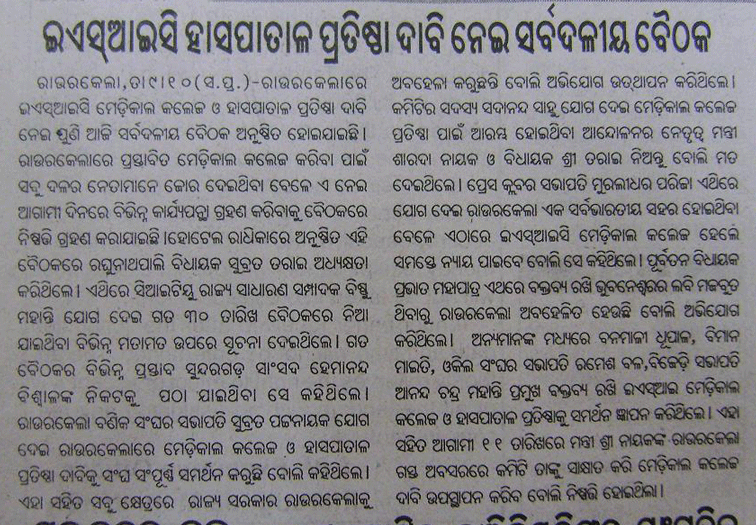
October 10th, 2009
Following is from Samaja.
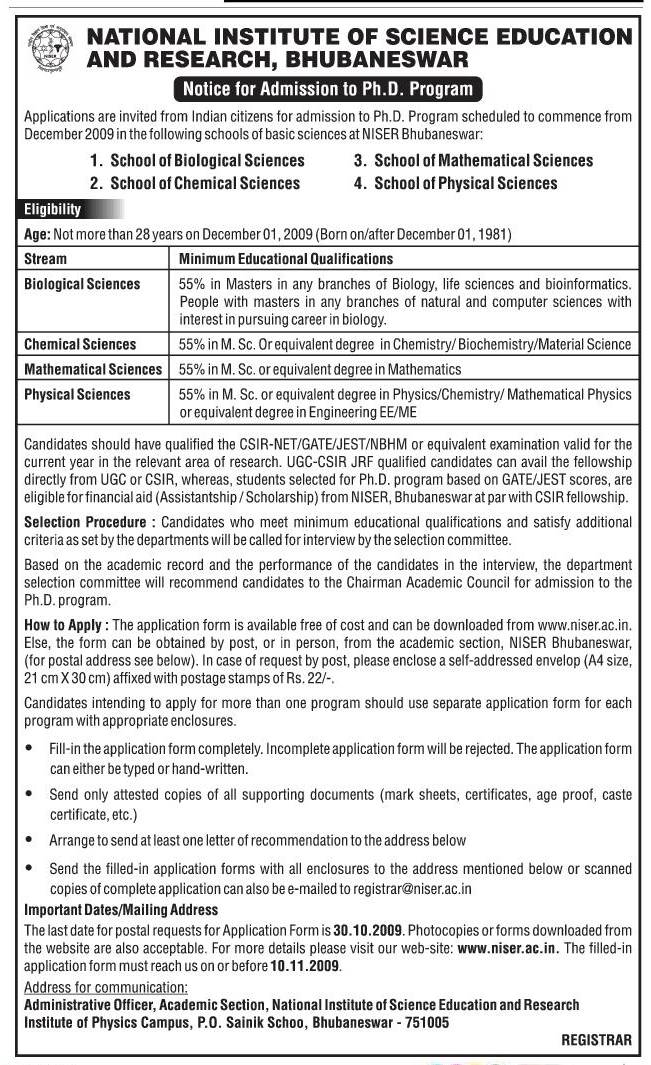
October 8th, 2009
Following is from a report in Pioneer.
The committee will study the present scenario of higher education in the State in all sectors, including industries, agriculture and medical.
The committee has been asked to suggest measures and means to improve the situation and bring it at par with international standards, keeping equity, excellence and inclusion of focus areas.
It will also suggest a draft higher education policy for the State. It will also prepare two annual action plans for 2011 and 2011-12 and two five years perspective plans for the State corresponding to the 12th and 13th Five Year Plan period up to 2021-22.
Besides the core objectives, sub-committee will be formed to examine expansion and structural configuration, quality and curricular concerns, governance issues including autonomy and regulatory systems and financing of higher education.
Higher Education Minister Debi Prasad Mishra said five regional consultative workshops will be held in Cuttack, Balasore, Sambalpur, Jeypore and Berhampur to elicit opinion of the intelligentsias and stake holders. After the regional workshop, a State level workshop will be held in Bhubaneswar.
The members of task force are:
- Professor Trilochan Pradhan: Founder and Retired Director, Institute of Physics and Ex-Vice-Chancellor of the Utkal University
- Prof KL Chopra (former Director, IIT Kharagpur), NBA
- Prof DP Pattnaik
- Prof DP Ray, VC, OUAT
- Prof AK Pujari, VC, Sambalpur University
- Prof Sunil Sarangi, Director, NIT, Rourkela
- Prof Chitta Baral, Arizona State University USA
- Prof Priyambada Hejmadi (former VC)
- Prof Swadhin Patnaik, Director, Institute of Mathematics
- Mr. Abani Baral
- Prof DV Raman, XIMB
- Prof LN Mishra, former Utkal University VC
- Prof Rabindra Ku Nanda, former Prof in Chemistry
- Prof Damodar Acharya, Director IIT Kharagpur
- Dr. Rajib Sahu, Resources Consultant
- Dr Achyut Samant, UGC member
- Mr. Madhusudan Padhi, IAS, Commissioner-cum-Secretary, Higher Education
In addition there will be many special invitees. As per a Times of India report, they include:
- All other vice-chancellors of universities in the state (Utkal, Berhampur, NOU, FMU, Ravenshaw, BPUT, VSSUT, Culture U, KIIT U, SOA U, NLUO, CUO, Sri Jagannath U)
- Director, NISER, Prof Chandrasekhar
- Ex-state information commissioner Radhamohan
- Director, IIIT, Bhubaneswar, Prof Gopal Nayak
- Commissioner-cum-state project director, OPEPA
- Director of higher education
- Director of secondary education
- Director of elementary education
- Director of technical education and training
- Director of medical education and training
- Prof Bhagaban Prakash
- Chairman, HDF, Prof D K Ray
- Prof Dhanada Mishra
- Prof M K Mishra
- Retired principal, R D Women’s College, Prof Bijaya Mishra.
Some of my initial thoughts are at http://orissa2020.org. (A lot of the thoughts there have been shaped with discussions with many people, especially Dr. Digambara Patra.) Please write me with your suggestions and feedback at orissavision2020@gmail.com. As various people know more about the areas they have had some connections (grew up there, went to school there, etc.), thoughts about particular town/city/district/area are most welcome and will be appreciated very much.
[I received a very thoughtful feedback about the Hinjlicut area. Since I did not know the exact details about where Berhampur is growing, where Hinjlicut is growing etc., the feedback helped me to better think about that area. Such ground level feedback is most welcome and very much appreciated.]
However, please do have a state-wide perspective.
The Central government, the knowledge commission as well as the state government are serious about improving the GER from 12.4% to 30% by 2020. The Knowledge Commission has recommended that the number of universities in India go up from 350 to 1500 and that there be 50 national universities. The higher education budget has been going up from one 5 yr plan to another; so I expect that during the 12th and 13th plan there will be more central and national universities. So a lot of new universities, colleges and institutes will be established. Plus, there may be opportunity for extension campuses of exisiting institutes, similar to IISc Bangalore’s plan for an extension campus in Chitradurga, Karnataka. So if we plan properly, we can mitigate a lot of inequality and incorporate a lot of inclusiveness. Please watch out for this blog as well as the site http://orissa2020.org.
My membership in the above committee, puts certain restrictions on my public activities. In particular, it means that I can no longer publicly campaign for X or Y issue (including the ESIC issue).
October 8th, 2009
Update: Various trade unions and local organizations in Rourkela have signed a joint memorandum. The details are at: http://www.odiasamaja.org/esic-medical-college-trade-unions-variour-organizations-support/.
Following is an excerpt from a report in Pioneer.
Hundreds of e-mails reached the Chief Minister’s Office (CMO) urging him to impress upon the Employees’ State Insurance Corporation (ESIC) for establishment of the college and hospital in the steel city. The Prime Minister and the Union Minister for Labour were flooded with mails and memorandums. Bur it seems nobody in the Government is bothered about the hue and cry raised by the people from various sections of the society.
“If there is any place fit for an ESIC Medical College & Hospital, it is Rourkela,” said a top Orissa Government official. Then how come the Government is silent over the demand and has allowed the ESIC to set up the college and hospital in Bhubaneswar? “You better ask the Chief Minister,” said the officer on the condition of anonymity. Now, as the ESIC has been allotted land on the outskirts of the capital city, chances of Rourkela seem remote, admitted the official.
Interestingly, when the people of Rourkela joined the bandwagon for demanding the medical college and hospital in the steel city, local MLA Sarada Prasad Nayak, who is the Minister for Food, Civil Supplies and Consumer Welfare remained silent. Similarly, Minister for Labour and Employment Puspendra Singh Deo, who also hails from Western Orissa, quietly favoured the college to come up in Bhubaneswar.
The ESIC will spend Rs 600 crore for the medical college and hospital, a dental college and a nursing college in the same campus, said sources. Officials point out that as there is no full-fledged airport near Rourkela, the Centre will not agree to setting up of a medical college there.
The mention about Rourkela not having airport and hence center may not agree is bogus. I don’t see any connection betweem an airport and an ESIC medical college. Indeed two other locations where ESIC medical colleges are being established do not have a nearby airport either. They are Gulbarga, Karnataka and Alwar, Rajasthan. (Thanks to Prashant babu for pointing to the second one.)
October 5th, 2009
The following appeared in Samaja. I wonder if there is some imminent move by Vedanta University project.
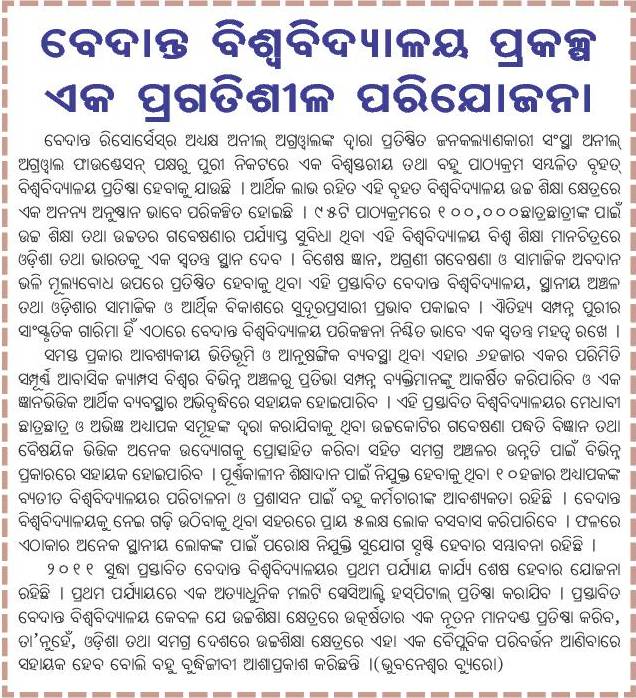
I am actually not sure if the above is an article or an ad. I think its an ad.
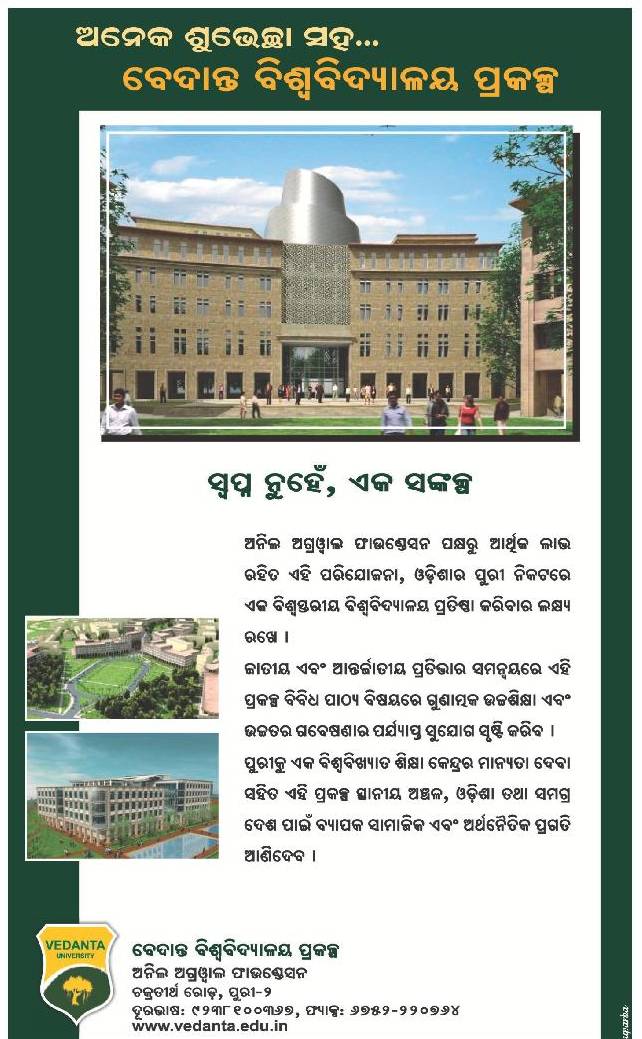
October 4th, 2009
Update: The following was written before I saw this article in Pioneer.
Tathya.in has a report on Dr. Digamabara Patra’s request for a national or central university in Bhawanipatna, Kalahandi. A lot of the arguments made there make sense. Many of the recent central universities have been established in rural and semi-urban areas and indeed there is no reason why one should not be established in Bhawanipatna; especially since its citizens have been asking for one for more than 2 decades.
However, as mentioned in the article https://www.orissalinks.com/archives/3229 adequate infrastructure seems to have been an important factor in determining the locations of the new IITs, IIMs and National universities.
For Orissa to have them in locations ouside of Bhubaneswar, there are two ways to go about it.
- Argue that adequate infrastructure should not be a requirement or they will automatically come once the institutions are established.
- Develop areas outside Bhubaneswar to have adequate infrastructure.
To me pursuing (2) has a higher chance of success than pursuing (1) and even if (1) is successful the institutes/universities in locations without appropriate infrastructure will struggle until the infrastructure eventually catches up which may take a long time if just left to fate. (Such a struggle may result in Orissa not being given in appropriate numbers additional central/national institutes.)
[In India people sometime point out that IIT Kharagpur was established in a rural location. First, Kharagpur is only 116 kms from Howrah. Second it has been a major railway junction for a long time. Third it was the first IIT and for a long time only one of 5 IITs. Similarly Roorkee was the oldest engineering college and is close to Haridwar and Dehradun. There are a few top universities and institutions in the US that are in rural areas, but these are exceptions, and the infrastructure in rural areas of US are quite good compared to rural areas of India. For example, Univ of Illinois at Urbana Champaign and Penn State University in State College, PA are often mentioned in that context. But both do have small airports with commercial flights.]
Before we suggest what needs to be done regarding developing areas outside Bhubaneswar to have adequate infrastructure, let us address what may be coming in the future and why Orissa needs to do this urgently so as to not risk missing future allocations of national institutions.
The National Knowledge Commission (NKC) in its December 2006 note on higher education has explicitly suggested 50 national universities in India. It says:
We recommend the creation of up to 50 National Universities that can provide education of the highest standard. As exemplars for the rest of the nation, these universities shall train students in a variety of disciplines, including humanities, social sciences, basic sciences, commerce and professional subjects, at both the undergraduate and post-graduate levels. The number 50 is a long term objective. In the short run, it is important to begin with at least 10 such universities in the next 3 years. It is worth noting that the National Universities need not all be new universities. Some of the existing universities could also be converted into National Universities, on the basis of rigorous selection criteria, to act as exemplars. We recognise that there could be a human resource constraint if faculty members are not available in adequate numbers to establish these universities.
The current government has implemented most of the recommendations of the NKC and exceeded some of them. For example, instead of the recommendation of 10 national universities in the three years following the report (2007-2010), establishment of 14 have been announced. Moreover, the higher education budget has been increasing drastically from one five year plan to the next. The 12th five year plan starts in 2012 and it is expected that it will take up on the long range objectives of the knowledge commission. In other words there could and should be more central and national universities in the 12th plan.
[My impression is that how soon additional national universities are established will depend on the success of the first 14. It seems to me that the locations of the first 14 have been greatly influenced by the consideration of, where in each of the states selecetd, does it have the best chance to succeed.]
Unless Orissa is prepared for it, Orissa may lose out pieces of those plans on lack of infrastructure grounds. Other states with multiple locations with adequate infrastructure will get preference and Orissa may lose out.
However, 2012 is still 3 years away and if adequate steps are taken very soon, Orissa should be able to get its fair share.
The pity is there are areas in Orissa which are on the verge of having the necessary infrastructure, mostly through private investment, but because of non-constructive opposition, blind suspicion towards industrialization and the relcucatnce of many to speak out in favour of development and industrialization, the development and associated infrastructure building has been greatly hampered. The governments (state and center) are also at fault for their sluggishness on some aspects.
Following are some suggestions:
- The state government should push for the completion of the airport in Jharsuguda within a year.
- It should make an all-out effort to have commercial flights operating out of the existing airport in Rourkela. In general, the people of the area need to recognize the existing infrastructure and potential of Rourkela and take advantage of it. Currently, as a friend of mine would say, Rourkela is an orphan. This is a pity. It is a big asset to Orissa, especially to the western parts of Orissa; but is severely underutilized and undermined.
- Coming back to Jharsuguda, the people there should follow a smarter approach in not opposing and rather facilitating industries coming up there, and at the same time being vigilant about environmental and land acquisition related R & R issues. If these industries and investment are allowed to materialize there soon, then Sambalpur-Jharsuguda area would become a large metro with adequate infrastructure to have and support any and all kinds of institutes and universities. But will the people do that? Or will they continue to be controlled by or scared of the anti-industry activists.
- Similarly, both Bhawanipatna (Lanjigarh to be precise) and Rayagada areas have industrial investors who have been senselessly opposed. If the people would take a smarter approach that mixes development with being vigilant about environmental and land acquisition related R & R then both these areas would be able to get infrastructure where a central university (and possibly more) would flourish. But will the people do that? Or will they continue to be controlled by or scared of anti-industry activists. In Lanjigarh, Kalahandi, the local MP has recently taken a more sensible approach. I hope there is a quick resolution as this area desperately needs development and the resulting infrastructure.
- The state government should push for the rail infrastructure, particularly, the Khurda-Balangir line, the Talcher-Bimlagarh line and connectivity to Kalahandi, to be completed at the earliest.
The above is extremely important for the development of the western parts of Orissa where there is often a feeling of neglect. If the people there do not follow a smarter approach and only follow the strange approach that many (not all) seem to be following (such as opposing industrialization and thus infrastructure building but wanting things that need infrastructure) the places that follow a smarter approach (inside and outside Orissa) would be gainers. The same is happening in some other places in Orissa too – Paradeep and Kalinganagar come to mind, but these places are in closer proximity to Bhubaneswar and because of that they may be less harmed.
October 4th, 2009
Update on 27th April 2011: The Central University location has been changed to Bander Sindri near Ajmer and only 80 kms from Jaipur. The Innovation University (previsouly referred to as National University) aiming for world class is now pushed for Jaipur. [Times of India].
Tathya.in has a report that mentions some official saying that because of the lack of an airport in Rourkela central government will not agree to have ESIC medical college in Rourkela. I think this is a completely frivolous argument; I don’t see much connection between an ESIC medical college and an airport. (Often airport is a codeword for adequate infrastructure. If that is the case Rourkela indeed has the infrastructure for an ESIC medical college.)
However, in regards to certain centrally funded institutions, such a requirement is in the background and mentioned by journalists, even if they may not be spelled out explicitly. So while pushing for an ESIC medical college in Rourkela, we should set our target to push for more functioning airports as a next action item. Following is a more detailed analysis.
Given below are the locations of some national institutions and some related attributes. It is easy to see that for the locations of IITs, IIMs and National Universities being near (say within 120 kms or 2 hrs) an operational airport has been an important factor. For national universities, in addition being in a large (1 million plus metropolitan area) area with other research institutes has also been spelled out as an important criteria and it is reflected in the locations that are picked.
On the other hand, the newly established central universities are in towns of all sizes and the locations of the NITs are mixed. The next level centrally funded but locally focused technological institutes, SLIET, Longowal, ABAGKC IET, Malda and Central Institute of Technology, Kokrajhar are on purpose established in rural areas and smaller towns. Unlike the NITs these institutions take only local students and also have programs focused on local needs. Nevertheless, their quality need not be bad. For example, SLIET is considered quite good.
Looking to the future following are some points relevant to Orissa.
- For Orissa to have future central institutions like IIM, SPA, etc. to be in a location outside of Bhubaneswar, Orissa must push for the quick establishment of airports and other infrastructure in other parts of the state. For example, the airports in Jharsuguda and Rourkela are the closest to be operational and they should have scheduled flights at the earliest. Otherwise new centrally funded institutions may again be established near Bhubaneswar and crying hoarse after the fact may not be productive.
- Similarly the knowledge commission has proposed the establishment of 50 national universities in the long run. Considering that the education budget significantly increases from one 5 yr plan to the next, I would not be surprised if there is another set of them made during the 12th plan. Orissa must be prepared for that and by that time (there is a short window) have other areas in Orissa with adequate infrastructure that are being deemed necessary for a national university.
- Orissa must take advantage of the industrial and investment interests in Orissa, mostly due to its minerals, and develop metropolitan areas with larger population base. Currently the local people are creating roadblocks rather than helping in such development.
- In 2010 we should do our best to convince the planning commission, the PM and MHRD that the 12th plan (starting 2012) should include more centrally funded institutions of the kind that can be located in rural or semi-urban areas. In particular,
- A centrally funded but locally focused technological institute (like SLIET) in all states. The one in Orissa could be located in Kalahandi or Balangir, the other two KBK districts that lack centrally funded institutions.
- Two regional universities in each major states that are funded 50-50 by the state and the center. (This would be better than one centrally funded institute.)
- Multiple branches of Indira Gandhi National Tribal University in districts with high tribal population.
The NITs.
| City/Town |
State |
Population of city/town |
Population rank |
| Delhi |
Delhi |
18,639,762 |
2 |
| Surat |
Gujarat |
3,196,799 |
10 |
| Jaipur |
Rajasthan |
3,102,808 |
11 |
| Patna |
Bihar |
2,656,318 |
13 |
| Nagpur |
Maharashtra |
2,569,775 |
14 |
| Bhopal |
MP |
1,751,766 |
17 |
| Allahabad |
UP |
1,272,612 |
31 |
| Jamshedpur |
Jharkhand |
1,252,815 |
33 |
| Srinagar |
J & K |
1,104,489 |
41 |
| Calicut |
Kerala |
1,000,802 |
46 |
| Tiruchirapalli |
Tamil Nadu |
963,237 |
49 |
| Jalandhar |
Punjab |
958,854 |
50 |
| Raipur |
Chhatisgarh |
795,104 |
56 |
| Dehradun |
Uttarakhand |
738,889 |
57 |
| Warangal |
Andhra Pradesh |
656,298 |
61 |
| Surathkal, Mangalore |
Karnataka |
612,374 |
66 |
| Pudducherry |
Pudducherry |
575,027 |
71 |
| Rourkela |
Orissa |
550,668 |
75 |
| Durgapur |
West Bengal |
543,922 |
77 |
| Shillong |
Meghalaya |
304,596 |
136 |
| Aizawl |
Mizoram |
295,864 |
140 |
| Imphal |
Manipur |
279,679 |
147 |
| Agartala |
Tripura |
218,028 |
184 |
| Silchar |
Assam |
209,543 |
193 |
| Kurukshetra (Thaneswar) |
Punjab |
157,609 |
249 |
| Panaji |
Goa |
142,336 |
271 |
| Kohima |
Nagaland |
103,210 |
407 |
| Gangkot |
Sikkim |
32,483 |
|
| Hamirpur |
Himachal Pradesh |
17,219 |
|
The IITs.
| City – Metropolitan area |
State(s) |
Metro population |
Metro rank |
State or country Capital |
Rank in state |
Number 1 in the state |
Nearest airpot |
Preferred airport |
| Bombay |
Maharashtra |
21347412 |
1 |
Yes |
1 |
picked |
in area |
same |
| Delhi |
UP, Delhi, Haryana |
18639762 |
2 |
Yes |
1 |
picked |
in area |
same |
| Chennai |
Tamil Nadu |
7305169 |
4 |
Yes |
1 |
picked |
in area |
same |
| Hyderabad |
Andhra Pradesh |
6290397 |
6 |
Yes |
1 |
picked |
in area (60 kms away) |
same |
| Gandhinagar – Ahmedabad |
Gujarat |
5334314 |
7 |
Yes |
1 |
picked |
Ahmedabad (40 kms) |
same |
| Kanpur |
Uttar Pradesh |
3494275 |
9 |
No |
1 |
picked |
in area (only Air India) |
Lucknow (80 kms) |
| Patna |
Bihar |
2656318 |
13 |
Yes |
1 |
picked |
in area |
same |
| Indore |
Madhya Pradesh |
2049193 |
15 |
No |
1 |
picked |
in area |
same |
| Bhubaneswar |
Orissa |
1666429 |
22 |
Yes |
1 |
picked |
in area |
same |
| Guwahati |
Assam |
1038071 |
44 |
Yes |
1 |
picked |
in area |
same |
| Ropar – Chandigarh |
Punjab |
1033671 |
45 |
Yes |
3 |
Ludhiana (19) |
Chandigarh (60 kms away) |
same |
| Jodhpur |
Rajasthan |
987919 |
47 |
No |
2 |
Jaipur (11) |
in area |
same |
| Kharagapur |
West Bengal |
511303 |
82 |
No |
5 |
Kolkata (3) |
Kolkata (120 kms away) |
same |
| Roorkee – Haridwar |
Uttarakhand |
250645 |
166 |
No |
2 |
Dehradun (57) |
Dehradun (1 hr away) |
Delhi (180 kms) |
| Mandi |
Himachal Pradesh |
32014 |
|
No |
3 |
Shimla (194) |
Kullu-Manali airport (60 kms away) |
same |
National Universities
| City – Metropolitan area |
State(s) |
Metro population |
Metro rank |
State or country Capital |
Rank in state |
Number 1 in the state |
Airport with scheduled flights |
Other airport nearby |
| NOIDA – Delhi |
UP, Delhi, Haryana |
18639762 |
2 |
Yes |
1 |
picked |
yes |
|
| Kolkata |
West Bengal |
15414859 |
3 |
Yes |
1 |
picked |
yes |
|
| Gandhinagar – Ahmedabad |
Gujarat |
5334314 |
7 |
Yes |
1 |
picked |
yes |
|
| Pune |
Maharashtra |
5273211 |
8 |
No |
2 |
Mumbai (1) |
yes |
|
| Jaipur |
Rajasthan |
3102808 |
11 |
Yes |
1 |
picked |
Yes |
|
| Patna |
Bihar |
2656318 |
13 |
Yes |
1 |
picked |
yes |
|
| Bhopal |
Madhya Pradesh |
1751766 |
17 |
Yes |
2 |
Indore (15) |
yes |
|
| Bhubaneswar |
Orissa |
1666429 |
22 |
Yes |
1 |
picked |
yes |
|
| Coimbatore |
Tamil Nadu |
1644224 |
23 |
No |
2 |
Chennai (4) |
yes |
|
| Kochi |
Kerala |
1541175 |
24 |
No |
1 |
picked |
yes |
|
| Visakhapatnam |
Andhra Pradesh |
1511687 |
26 |
No |
2 |
Hyderabad (6) |
yes |
|
| Mysore |
Karnataka |
1230039 |
34 |
No |
2 |
Bangalore (5) |
New airport but no scheduled flights yet |
140 kms from Bangalore |
| Amritsar |
Punjab |
1206918 |
36 |
No |
2 |
Ludhiana (19) |
yes |
|
| Guwahati |
Assam |
1038071 |
44 |
Yes |
1 |
picked |
yes |
|
New Central Universities
| City – Metropolitan area |
State |
Metro population |
| Gandhinagar – Ahmedabad (temporary?) |
Gujarat |
5,334,314 |
| Srinagar |
J & K |
1,104,489 |
| Khunti, Ranchi |
Jharkhand |
1,066,449 |
| Jammu |
J & K |
690,924 |
| Bikaner (Changed to be in Bander Sindri, near Ajmer, 80 kms from Jaipur) |
Rajasthan |
624,577 613,293 |
| Gulbarga |
Karnataka |
534,417 |
| Sagar |
Madhya Pradesh |
351,537 |
| Bilaspur |
Chhatisgarh |
319,129 |
| Bathinda |
Punjab |
269,520 |
| Koraput-Sunabeda-Jeypore |
Orissa |
200,000 |
| Motihari |
Bihar |
121,475 |
| Tiruvarar |
Tamil Nadu |
61,270 |
| Kasaragod |
Kerala |
52,683 |
| Tehri Garhwal |
Uttarakhand |
25,425 |
| Mahendragarh |
Harayana |
23,977 |
| Kangra |
Himachal Pradesh |
9,155 |
IIMs
| City – Metropolitan area |
State |
Metro population |
Airport |
| Kolkata |
West Bengal |
15414859 |
in area |
| Bangalore |
Karnataka |
6466271 |
in area |
| Ahmedabad |
Gujarat |
5334314 |
in area |
| Lucknow |
Uttar Pradesh |
2991280 |
in area |
| Indore |
Madhya Pradesh |
2049193 |
in area |
| Ranchi |
Jharkhand |
1066449 |
in area |
| Kozhikode |
Kerala |
1000802 |
in area |
| Tiruchirapalli |
Tamil Nadu |
963237 |
in area |
| Raipur |
Chhatisgarh |
795104 |
in area |
|
Dehradun
Kashipur
|
Uttarakhand |
738889
92978
|
in area
72 km away in Pantnagar
|
| Udaipur |
Rajasthan |
456994 |
in area |
| Rohtak |
Haryana |
340319 |
71 kms from Delhi |
| Shillong |
Meghalaya |
304596 |
in area |
October 4th, 2009
Following is from http://www.ugc.ac.in/notices/notificationworduniviersity.pdf.
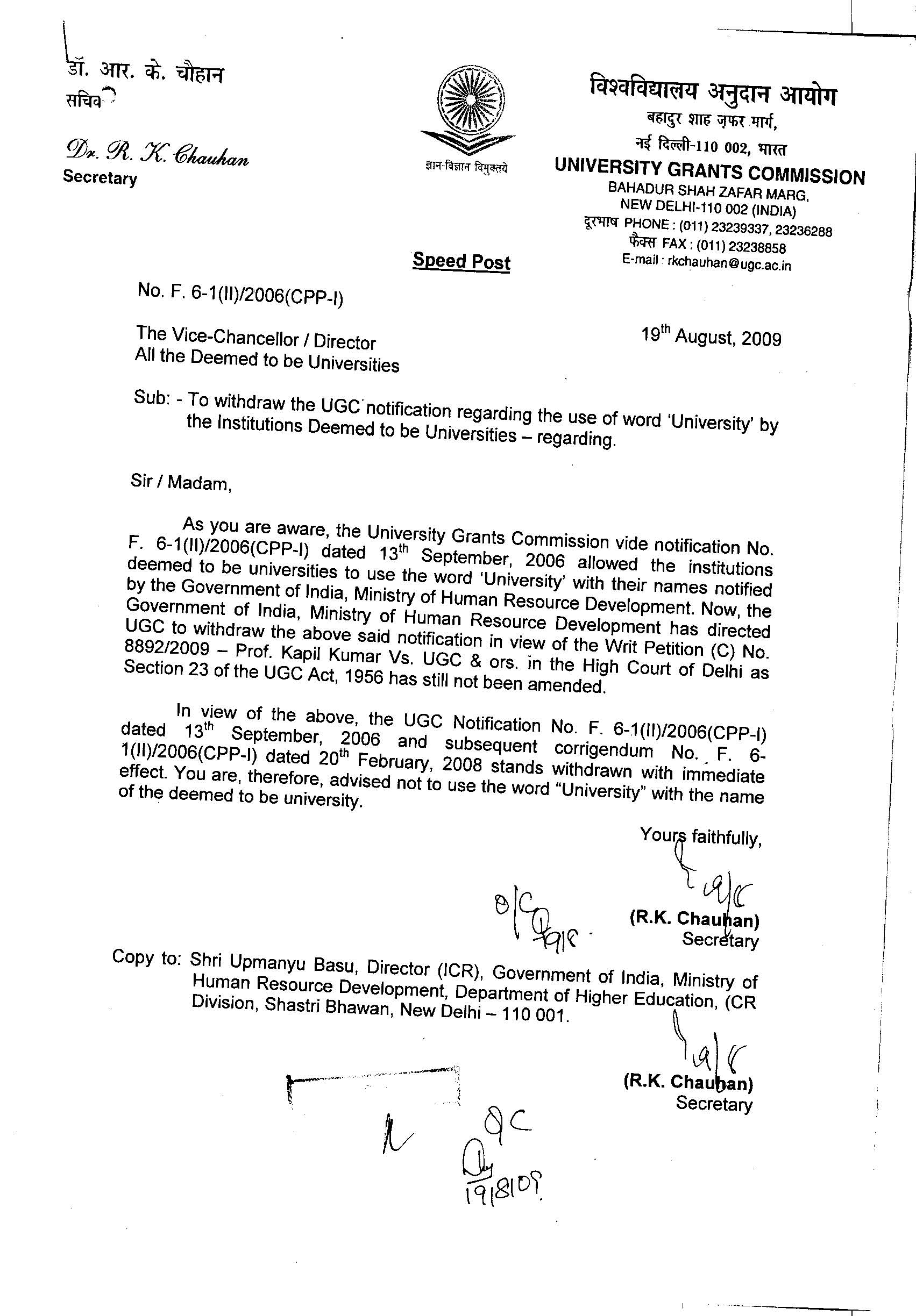
This means KIIT, SOA and other institutions deemed to be universities should no longer be using the word ‘University’ in their name. Also, it validates our earlier effort to convince the people pushing to make UCE Burla a deemed university to go for a state university status instead. Not only it was easier to get the state university status (the new deemed to be universities applications are frozen for now), but now VSSUT is a university and unlike KIIT and SOA, VSSUT can use the word ‘university’.
October 3rd, 2009
Following is an excerpt from a report in dnaindia.com.
Jayalakshmi Venugopal / DNA, Thursday, September 10, 2009 9:03 IST
The Planning Commission approved "in principle" plans of the Union ministry of human resources development to establish 20 new Indian Institutes of Information Technology (IIITs) under the 11th Five Year Plan across various locations in India.
The National Association of Software and Services Companies (NASSCOM), the trade body of the IT and BPO sector, was entrusted with the task of preparing a detailed project report (DPR) which would incorporate a model of private-public partnership in the setting up of these new institutes.
This plan, prepared by NASSCOM, was submitted in May 2008, and has now been granted the Planning Commission’s go-ahead.
However, it is still awaiting the green signal from the finance committee of the Union government and the central cabinet.
October 3rd, 2009
Following is an excerpt from a report in Expressbuzz.com.
The Orissa unit of CITU with support from mainstream political parties has renewed the demand to set up the proposed medical college and hospital (MCH) of the Employees’ State Insurance Corporation (ESIC) at Rourkela. An action committee formed today at an all-party meeting resolved to put pressure on the State Government to pave way for locating the MCH at Rourkela having high concentration of ESIC insured persons (IPs).
… Led by Orissa unit CITU general secretary Bishnu Mohanty, the meeting pointed out that of the 2.4 lakh IPs across Orissa, the industrial and mining district of Sundargarh along with adjacent Keonjhar, Jharsuguda and Sambalpur districts account for 1.4 lakh IPs. Hence, there is no justification in locating the MCH in Bhubaneswar which has a number of MCHs and super specialty hospitals, the meeting observed.
Following is an excerpt from a report in Pioneer.
Resentment is growing among the Rourkelites, with the Government’s decision of setting up an ESIC Medical College and Hospital in Bhubaneswar. Irrespective of party affiliations, a forum has come up to pursue Naveen Patnaik to relocate the ESIC Medical College here.
On this issue, an all-party meeting was convened in the district committee office of CITU on Wednesday under the chairmanship of Rourkela Press Club president Muralidhar Parija. Among others, CITU State general secretary Bishnu Mohanty, former Rourkela Congress MLA Pravat Mohapatra, Rourkela BJD president Ananda Mohanty, former Rourkela Municipal chairman and president Rourkela Bar Association Ramesh Bal, CPI(M) Sundargarh district committee secretary Banamali Dhupal, CITU leaders Biman Maity, Jahangir Ali, CPI leaders Pravat Mishra, Pradyosh Mohanty, SK Chakraborty, HMS leader Arun Parida, senior journalist AP Biswal spoke on the occasion and expressed their solidarity in their demand for ESIC Hospital.
Following is from Samaja. (Thanks to http://www.odiasamaja.org/ for the pointer.)
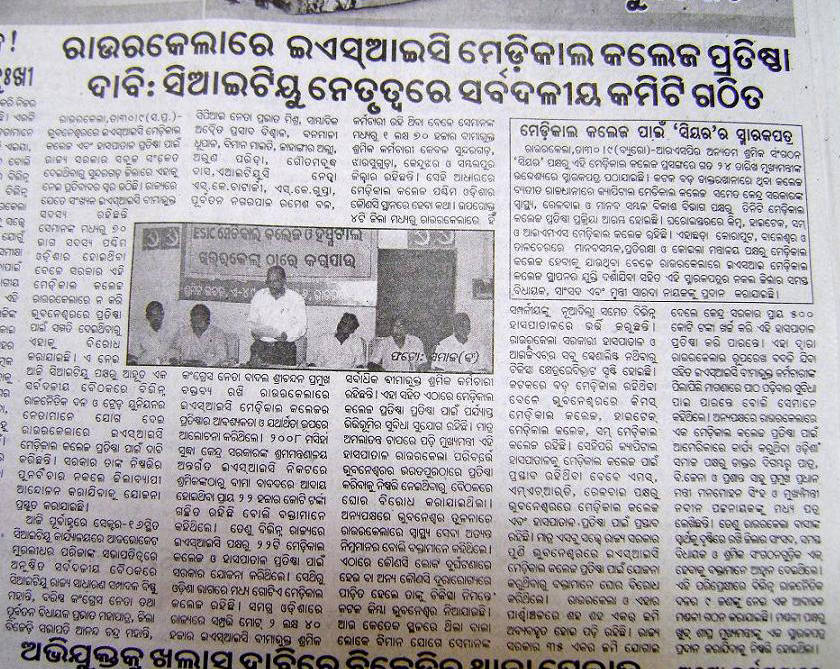
Following is from Dharitri. (Thanks to http://www.odiasamaja.org/ for the pointer.)
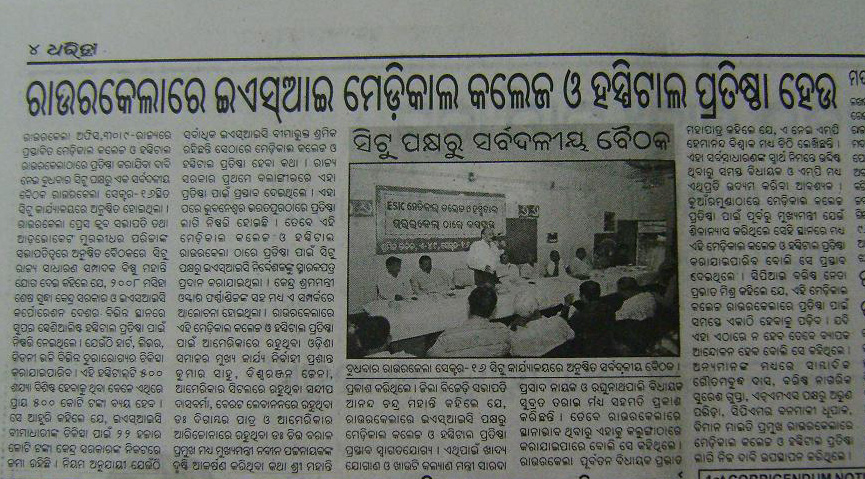
Following is from Dainik Bhaskar. (Thanks to http://www.odiasamaja.org/ for the pointer.)
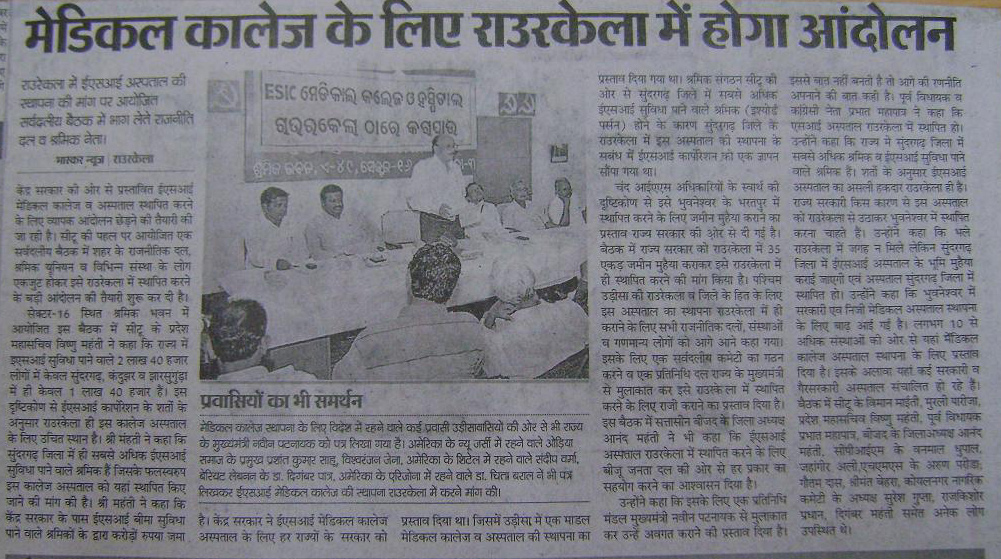
October 2nd, 2009
The following table is from a Current science article by G. Prathap and B. M. Gupta. It gives a ranking of top 25 universities in India in term of their publications. The detailed methodology of the ranking is discussed in the above mentioned article. The same authors earlier ranked the engineering and technological institutes which we discussed here.
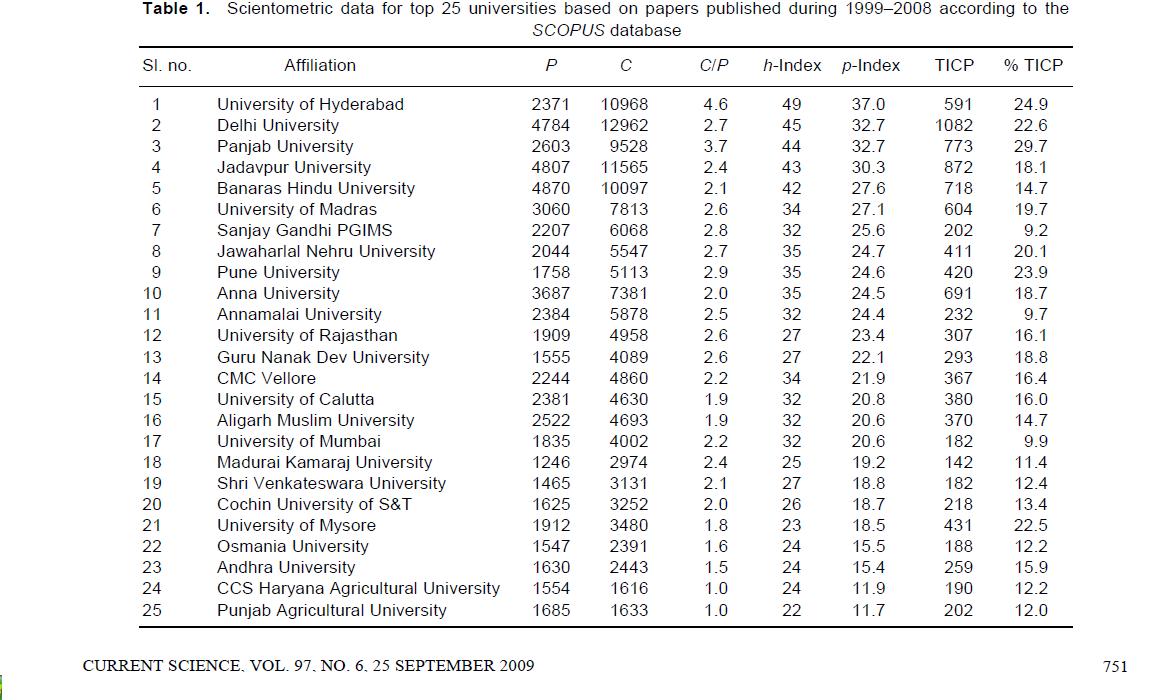
October 1st, 2009
Update on Oct 1 2009: Pioneer has a nice article on the ESIC Medical College in Rourkela theme.
Following appeared in Sambada. Thanks to http://www.odiasamaja.org for the image.
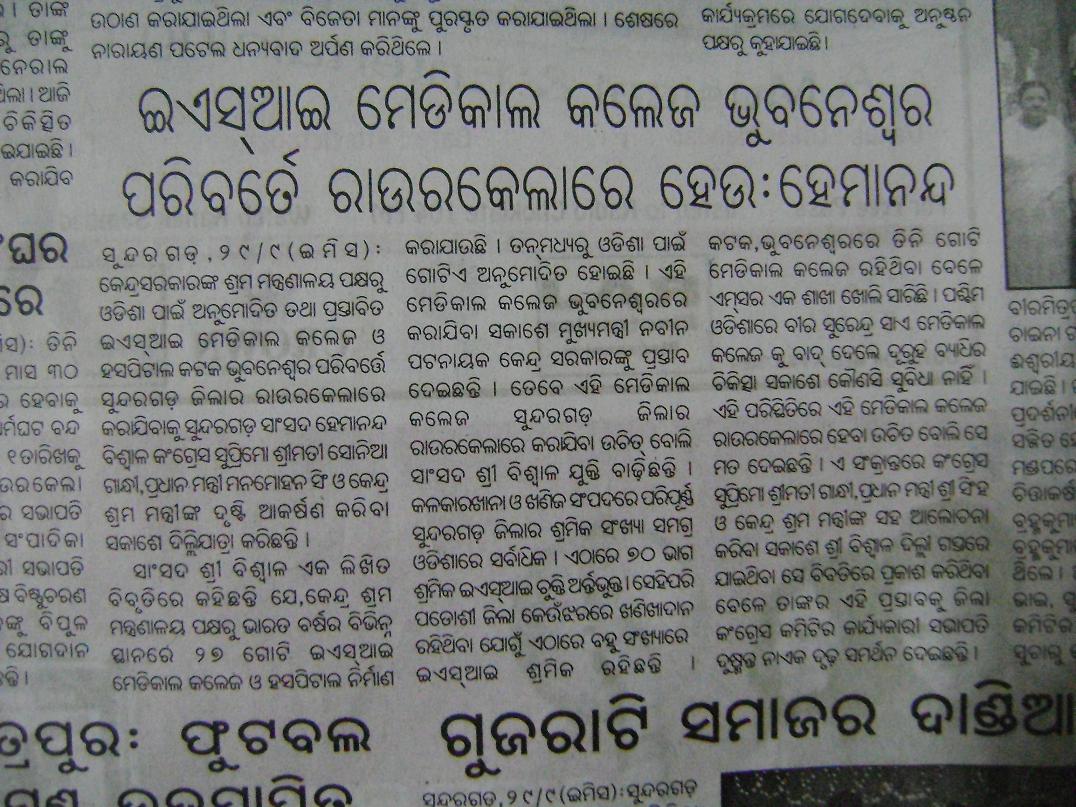
See http://www.odiasamaja.org/esic-medical-college-rkl-press-conference-report/ for a press conference that happened yesterday. Some of us participated by phone.
September 30th, 2009
Following is an excerpt from an IANS story by Prashant Nanda that we found in a report in thaiinidan.com.
… “We will retain our original name (NIT-Warangal) but it will become an integrated university with both medical and legal education among other programmes beyond engineering and technology.
“We will also provide postgraduate courses in humanities, business economics, biotechnology and many others. The focus will gradually shift to from under-graduation to post-graduation and research,” Rao explained.
NIT Warangal is the first among the NITs. It was dedicated to the nation by the first prime minister Jawaharlal Nehru way back in 1959. Then it was known a regional engineering college. The institute is older than many IITs, including IIT-Delhi.
… The director said the institute, which started its journey with a little over 100 students from a temporary campus, now boasts of 4,200 students. In 2006, the institute had 2,000 students of which 1,600 were pursuing B.Tech courses and the rest M.Tech.
“While all the central government institutes are implementing the OBC (Other Backward Classes) quota in three years, we did it at one go. With an increase in the number of seats, we have shifted our focus to post-graduation and research. Out of 4,200 students, currently 1,400 are M.Tech students and 300 are PhD scholars,” Rao added.
Like the Massachusetts Institute of Technology (MIT) in the US, NIT-Warangal will become an integrated university and provide all kinds of courses to students to help the country move forward in the field of higher education, he said.
“The process of becoming a university will start from the coming academic session but it may take a few years to become a full-fledged one. We are targeting 5,000 students by 2011 and 15,000 by 2015,” Rao said, elaborating on his mega plan.
“We are planning to have the school of medical science next year. We are going to give emphasis on biotechnology and microbiology and here the school of medical science will help us grow in both research and innovation.”
NIT Roukela has recently started a program in Biotechnology and is about to start MBA. But it must go beyond and pursue a medical school.
September 29th, 2009
Some of the first five IITs in Kharagpur, Mumbai, Chennai, Kanpur and Delhi were developed through mentorship by various foreign countries and organizations such as UNESCO. For example, IIT Bombay was helped by UNESCO and Soviet Union, IIT Madras was helped by Germany and IIT Kanpur by a consortium of 9 US universities.
The Union HRD minister Mr. Kapil Sibal seems to be looking for similar help for establishing the 14 innovation universities. Following is an excerpt from a report in Economic Times.
The ministry for human resource development is keen to tie up with the world’s leading universities to ensure that its “innovation universities” are a class apart from the pack. During his visit to the US in late October, the minister for human resource development Kapil Sibal would like to firm up MoUs with leading US universities to collaborate with the proposed innovation universities.
Among the American Universities that are being approached are Yale, Standford and MIT. The government plans to set up 14 innovation universities over the next few years.
The government proposes to set up these universities as “global centres of innovation” and would like to draw on the talent and expertise of leading universities. “We are looking for a collaboration for two or three of the innovation universities,” a senior ministry official said. India has had a history of collaborating with leading international universities to set up her own world class institutions.
… Mr Sibal, who will be travelling to the US ahead of Prime Minister Manmohan Singh’s state visit in November, will leading a delegation to put in place the India-US Education Council.
September 29th, 2009
Next Posts
Previous Posts









